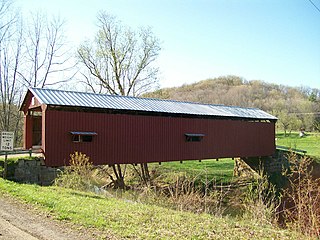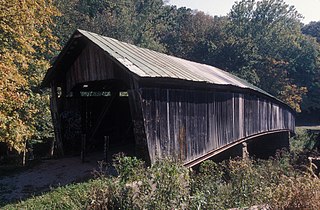
A truss bridge is a bridge whose load-bearing superstructure is composed of a truss, a structure of connected elements, usually forming triangular units. The connected elements, typically straight, may be stressed from tension, compression, or sometimes both in response to dynamic loads. There are several types of truss bridges, including some with simple designs that were among the first bridges designed in the 19th and early 20th centuries. A truss bridge is economical to construct primarily because it uses materials efficiently.

Windsor Mills Bridge, also known as Wiswell Road Bridge or Warner Hollow Road Bridge, is a covered bridge that carries Covered Bridge Lane, formerly Wiswell Road, across Phelps Creek in Windsor Township, Ashtabula County, Ohio, United States. The bridge, one of currently 17 drivable bridges in the county, is a single-span Town truss design. The bridge was built in 1867 using white pine. It sits atop cut stone abutments, one made of sandstone quarried nearby, and the other made of creek stone. The bridge was bypassed in the 1960s and closed to traffic, and Wiswell Road was rerouted west of the creek. In the 1980s, the bridge was completely closed due to safety reasons. It underwent extensive renovation from 2002 to 2004, and was then reopened to all traffic, except for trucks and buses. The bridge is listed in the National Register of Historic Places. The bridge's WGCB number is 35-04-25, and it is located approximately 5.0 mi (8.0 km) west of Orwell.

The Columbia Bridge is a covered bridge, carrying Columbia Bridge Road over the Connecticut River between Columbia, New Hampshire and Lemington, Vermont. Built in 1911–12, it is one of only two New Hampshire bridges built with Howe trusses, and is one of the last covered bridges built in the historic era of covered bridge construction in both states. It was listed on the National Register of Historic Places in 1976.

The Melcher Covered Bridge, also known as the "Klondyke Covered Bridge", "Marion Covered Bridge", or the "Leatherwood Covered Bridge" crosses Leatherwood Creek east of Montezuma, Indiana, and is a single-span Burr Arch Truss covered bridge structure that was built by Joseph J. Daniels in 1896.

Bergstresser / Dietz Bridge, the last remaining covered bridge in Franklin County, Ohio, United States, is located within the village limits of Canal Winchester, Ohio in southeastern Franklin County. The wooden bridge crosses Little Walnut Creek, which is a tributary of the Scioto River. Although the bridge is in serviceable condition, it is only open to foot traffic.

The McColly Covered Bridge is a historic wooden covered bridge in western Logan County, Ohio, United States. Located in Washington Township near the community of Bloom Center, it is one of two remaining covered bridges in Logan County. It carries County Road 13 over the Great Miami River, approximately 5 miles (8.0 km) south of its source at Indian Lake.

The Harra Covered Bridge is a historic wooden covered bridge in Washington County, Ohio, United States. Located in western Watertown Township, about 2 miles (3.2 km) north of the community of Watertown, the bridge spans the South Branch of Wolf Creek near the intersection of State Route 339 and Township Road 172. Among the bridge's more distinctive features are its cut stone abutments, its metal roof, and the vertical siding. Although it has been open for well over one hundred years, it remains in strong structural condition, and it served daily traffic into the late twentieth century.

The South Salem Covered Bridge is a historic covered bridge in northwestern Ross County, Ohio, United States. It was built in the 1870s and has been designated a historic site because of its well-preserved historic engineering. Since its construction, it has carried Lower Twin Road over Buckskin Creek in Buckskin Township. The bridge is a wooden Smith truss bridge, built in 1873 according to a design patented by Ohioan Robert Smith in the late 1860s. Eight wooden panels wide, it rests on stone abutments and is covered with a metal roof.

The Clinton Falls Bridge, also known as the Old Mill Bridge and formally as Bridge L-5573, is a historic steel Pratt through truss bridge that spans the Straight River in Clinton Falls Township, Minnesota. It was listed on the National Register of Historic Places in 1997 as Bridge No. L-5573 for having local significance in the theme of engineering. It was nominated for being an example of early steel truss bridge design in Minnesota.

The Shinn Covered Bridge is a historic wooden covered bridge in the southeastern part of the U.S. state of Ohio. Located in the countryside northeast of Bartlett in Washington County, this single-span truss bridge was built in 1886 by local carpenter Charles T. Shinn. Built of weatherboarded walls with stone abutments and a metal roof, the bridge features vertical siding, and its portals have remained vertical and resisted creeping into another shape. The heart of the bridge's structure employs the Burr Truss design, which mixes the king post truss with a wooden arch designed by Andrea Palladio in the sixteenth century. Shinn built his bridge to span the western branch of Wolf Creek in Palmer Township. Measuring 98 feet (30 m) in length, the bridge was constructed soon after the drowning of one of Shinn's children.

The Mull Covered Bridge is a historic wooden covered bridge in the northwestern portion of the U.S. state of Ohio. Built in the middle of the nineteenth century, it is located near Burgoon in Sandusky County. Although it is no longer used to facilitate transportation, the bridge has been preserved and is now a historic site.

The Warnke Covered Bridge, also known as Warnke Bridge, is a historic covered bridge crossing Swamp Creek in Harrison Township, Preble County, Ohio, northeast of Lewisburg. Built from 1895 to 1896 by Everett S. Sherman, it has a span of 51 feet. It was listed on the National Register of Historic Places in 1976.

The McDonald Farm is a historic agricultural complex near the city of Xenia in Greene County, Ohio, United States. It has been named a historic site, largely because of a quarry on the farm, which supplied stone for the Washington Monument.

The Eldean Covered Bridge is a historic covered bridge spanning the Great Miami River in Miami County, Ohio north of Troy. Built in 1860, it is one of the nation's finest surviving examples of a Long truss, patented in 1830 by engineer Stephen H. Long. At 224 feet (68 m) in length for its two spans, it is the longest surviving example of its type. It was listed on the National Register of Historic Places in 1975, and was designated a National Historic Landmark in 2016.

The Dinkey Creek Bridge, also known as Fresno County Bridge No. 42C-04, is a single-span, timber bowstring arch truss bridge that crosses Dinkey Creek in Fresno County, California, within Sierra National Forest. Built in 1938, it closed to automobile traffic in 1965 and was renovated in 1988 to replace rotting timbers. Designed by T.K. May, it was built by the U.S. Forest Service with Civilian Conservation Corps (CCC) labor. The structure was listed on the National Register of Historic Places in 1996.

The Ponn Humpback Covered Bridge was a historic covered bridge in the southeastern part of the U.S. state of Ohio. Located near the village of Wilkesville in Vinton County, it bore a name derived from its unusual shape: the bridge was arched in the middle, rather than being flat like a typical covered bridge. Declared a historic site in the 1970s, the bridge had a history closely tied to arson — it was constructed to replace a bridge that had been burned intentionally, and it met its end at the hands of an arsonist.

The Bell Covered Bridge is a historic wooden covered bridge in rural Washington County, Ohio, United States. One of several such bridges in the region built by the same man, it remained open to traffic with the exception of periodic repairs, until it was permanently closed on September 12, 2022, and it has been named a historic site.

Potter's Covered Bridge, also known as Potter's Bridge and Potter's Ford Bridge, is a historic covered bridge located in Potter's Bridge Park in Noblesville in Noblesville Township, Hamilton County, Indiana. It was built in 1871, and is a Howe truss structure measuring 260 feet long, 22 feet wide, and 20 feet tall. The single span bridge rests on limestone abutments and has walls clad in vertical board siding.

The Howe Covered Bridge is a historic covered bridge carrying Belknap Brook Road across the White River in Tunbridge, Vermont, just east of Vermont Route 110. Built in 1879, it is one of five surviving bridges in the town, one of the highest concentrations of covered bridges in the state. It was listed on the National Register of Historic Places in 1974.

The Kidwell Covered Bridge, in Dover Township, Athens County, Ohio between the nearby hamlets of Truetown and Redtown, was built in 1880. It spans Sunday Creek. It was listed on the National Register of Historic Places in 1977.























